StoneCau: Ground stone tool perspective on the Late Chalcolithic Caucasus
Decoding economy of the Leylatepe communities in the Chalcolithic Caucasus through functional analyses of ground stone tools
Project team FU:
Postdoctoral researcher: Dr. Karolina Hruby
Host supervisor: Prof. Dr. Henny Piezonka
Cooperation partners:
Dr. Caroline Hamon, Laboratoire Trajectoires (UMR 8215), Centre national de la recherche scientifique (CNRS), Paris
Dr. Mark Iserlis (Lowland Karabakh Research and Excavation Project), Eurasien-Abteilung, Deutsches Archäologisches Institut, Berlin
Dr. Khagani Almamedov (Lowland Karabakh Research and Excavation Project), Institute of Archaeology and Anthropology, Azerbaijan National Academy of Sciences, Baku
Prof. Ruben Badalyan, Institute of Archaeology and Ethnography of the National Academy of Sciences, Yerevan
Dr. Armine Harutyunyan, Institute of Archaeology and Ethnography of the National Academy of Sciences, Yerevan
Project start: 01.09.2025
Funding: EU REA, Marie Skłodowska-Curie Actions (HORIZON-MSCA-2023-PF, project 101155720—StoneCau)
Project description
Background
During the Chalcolithic period, south-west Asia was at the onset of social complexity, marked by shifting economic dynamics and increased social differentiation. In the southern Caucasus, after nearly a millennium-long settlement decline, the emergence of the Leylatepe cultural phenomenon in the Late Chalcolithic (c. 4,000–3,500 BC) seems a turning point for the development of social differentiation, specialized craft industries, and interregional product exchange within the region. The Leylatepe-type settlements emerged in the diverse landscape of the southern Caucasus with a set of attributes with Upper Mesopotamian associations: rectilinear mudbrick architecture, wheel-made, chaff-faced pottery, infant jar burials – all very different in nature from earlier Caucasian traditions. For that reason the Leylatepe phenomenon for a long time was perceived as a ’flat’ case of unidirectional migration. However, the research has long been troubled by a shortage of reliable fieldworks, well-dated contexts, and lack of systematic studies of the technological practice or subsistence strategies, and tool use in the Leylatepe phenomenon. In 2022, the new excavation project by Dr. Mark Iserlis from the Deutsches Archäologisches Institut in Berlin and Dr. Khagani Almamedov from the Azerbaijan National Academy of Science in Baku (Lowland Karabakh Research and Excavation Project—LKREP; Gerda Henkel Stiftung AZ 04/F/25, AZ 39/V/24, DFG IS 312/3-1) was launched. Since then, three seasons of excavations at Leylatepe and Janavartepe in western Azerbaijan has yielded abundant evidence of the internal variability of material culture and lifeways within the phenomenon, and its potentially complex origins. They also yielded a sizable assemblage of ground stone tools.
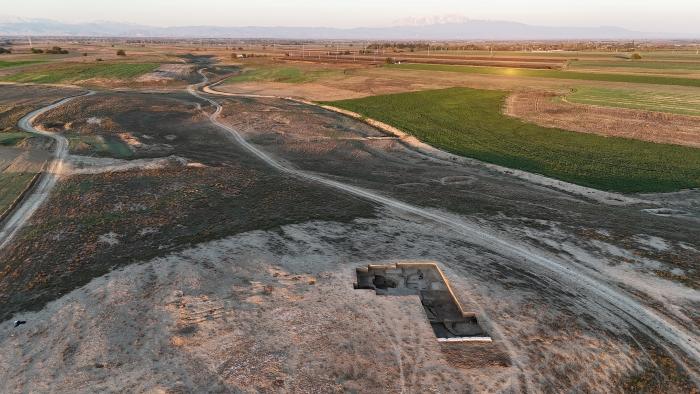
Fig. 1. Area B-C at Janavartepe (Karabakh Steppe, Azerbaijan) with a view to the west, 2024 (photo: (DJI) K. Hruby; LKREP).
Project aims and approach
Supported by the Marie Skłodowska-Curie Actions program, StoneCau explores the socio-economic development in the Late Chalcolithic southern Caucasus, with a focus on the Leylatepe phenomenon. The project includes the first-ever, broad-cut functional analyses of ground stone tools from four Leylatepe sites in present-day Azerbaijan and Armenia. StoneCau taps into the potential formed by the high-resolution excavations of LKREP at Janavartepe and Leylatepe (Karabakh Steppe, Azerbaijan), which enable studies on a large number of ground stone tools coming from clear, well-dated and documented settlement contexts. From there, it expands to incorporate the collections from Alhantepe (Mughan Steppe, Azerbaijan) and Teghut (Ararat Valley, Armenia) into the functional and comparative analyses.
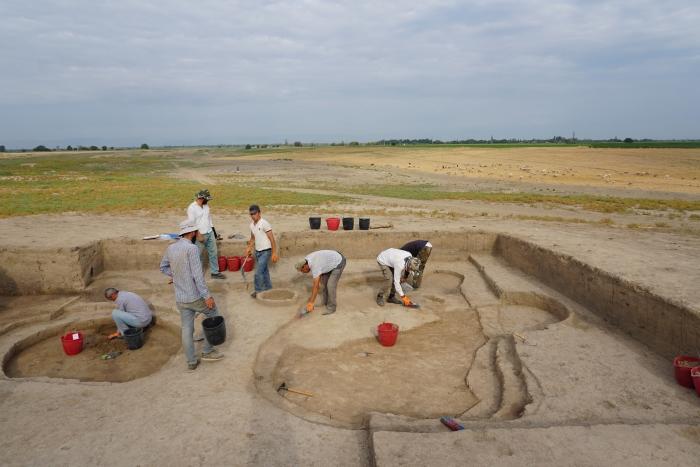
Fig. 2. Uncovering two pithouses in Area C at Janavartepe, 2022 (photo: M. Iserlis; LKREP).
Ground stone tools were typically used by the late prehistoric communities to perform a variety of mundane subsistence tasks as well as in specialized crafts developed during the Late Chalcolithic (like wheel-made pottery production or extractive copper metallurgy). Through the microscopic use-wear and experimental analyses of the tools, integrated with the technological, contextual, and relational approaches, StoneCau delves into the daily lives, food choices, and technological preferences of Leylatepe communities. The aims are to identify types of food- or craft-related tasks performed by the Leylatepe population on a daily basis, reconstruct the means and organization of their food and craft production on household, settlement, and supra-settlement levels, and establish what significance each of the activities had in the Leylatepe staple economy. The project also involves close cooperation with other specialists involved in LKREP and working on the archebotanical and zooarchaeolgical remains and ceramic technology, with a goal to integrate various groups of evidence and form a detailed picture of the Leylatepe subsistence. Emphasis is put on understanding if (and how) the Leylatepe-type settlements situated in different parts of the southern Caucasus – within varied ecological settings and with differentiated access to resources – differed in terms of economic strategies and technological practice. The results will bring to light the nature and extent of variability within the phenomenon and let us explore further its origin story and connections with ancient Mesopotamia.
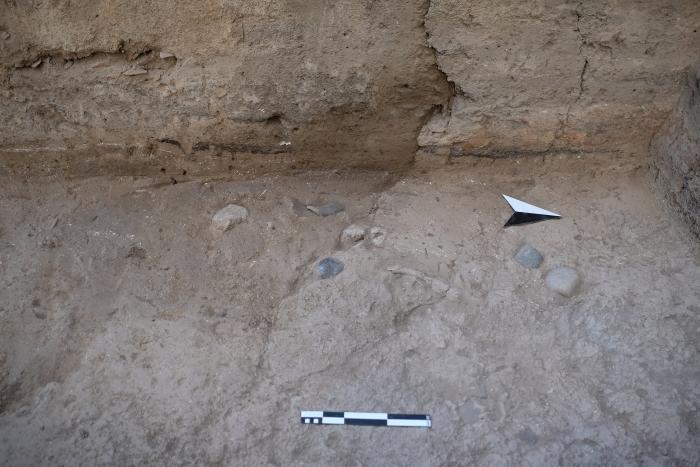
Fig. 3. Concentration of ground stone tools and other finds on the floor of a Late Chalcolithic building in Area TA at Leylatepe, 2025 (photo: M. Iserlis; LKREP).
Previous work
During the preceding year and with support of the postdoctoral fellowship of the Minerva Stiftung (Max-Planck-Gesellschaft für die Forschung mbH) and the Eurasia Department of Deutsches Archäologisches Institut in Berlin, Dr. Karolina Hruby created a record of ground stone tools from seven Chalcolithic sites in the southern Caucasus, and conducted the typo-morphological classification and technological analyses of the tools. This research ultimately led to the determination of the repertoire of ground stone tools characteristic of the Leylatepe phenomenon and formed the foundation that facilitates functional and comparative analyses conducted within the StoneCau project. In addition, in cooperation with the Lowland Karabakh Research and Excavation Project and Dr. Jingping An from the Institute of Pre- and Protohistoric Archaeology at the Christian-Albrecht University in Kiel, a pilot study was initiated, aiming at the identification of micro-botanical remains from a sample of grinding and pounding implements found in situ at Janavartepe and Leylatepe in 2024 and 2025.
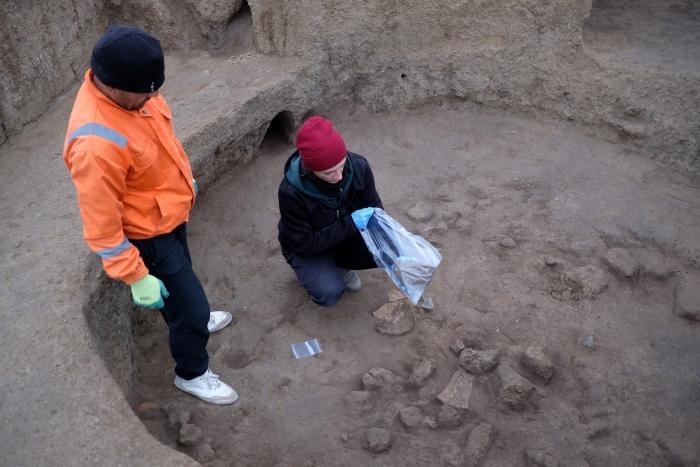
Fig. 4. Central pithouse in Area A at Janavartepe, K. Hruby collecting grinding stone samples for the identification of micro-botanical remains, 2024 (photo: M. Iserlis; LKREP).
Outlook
The LKREP excavations are ongoing and expected to provide a growing scope of the evidence allowing to further analyze and interpret the Leylatepe ground stone tool apparatus, technology, and functionality. The first results of the research conducted with the support of the Minerva Stiftung are published and further publications are under way. StoneCau will result in publications in peer-reviewed journals, which will bring the functional aspects of the tools and the Leylatepe economy to a broad scientific public. The final publication will provide a synthesis of the knowledge gained though the ground stone tool research involving various Leylatepe-type sites – both the technological and functional aspects of the tradition and its implications for our understanding of the Late Chalcolithic in the southern Caucasus as a whole. A workshop bringing together researchers actively working on the Leylatepe phenomenon is planned in 2027.
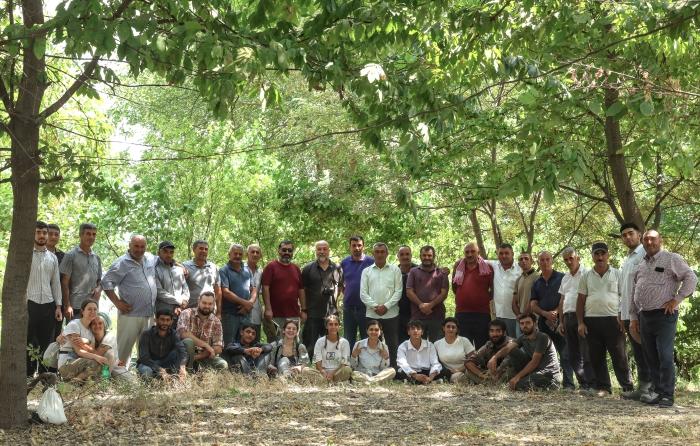
Fig. 5. LKREP fieldwork team at Leylatepe, 2025 (photo: M. Iserlis; LKREP).
Related publications
Iserlis, M., Almamedov, K., Hruby, K., Maurer, G., Joka, K., Aghalarov, M., Heit, I., Poulmarch, M. (2025) Preliminary results of the study of two Late Chalcolithic settlements in the Karabakh steppe. Azerbaijan Journal of Archaeology and Anthropology 1(1): 30–43. doi:10.30546/679523.1.2025.26
Hruby, K., Iserlis, M., Harutyunyan, A., Badalyan, R. Macrolithic strategies in the south Caucasus Chalcolithic: Ground stone tools from Teghut (Ararat Plain, Armenia) in the regional context. (In submission to Paléorient)

